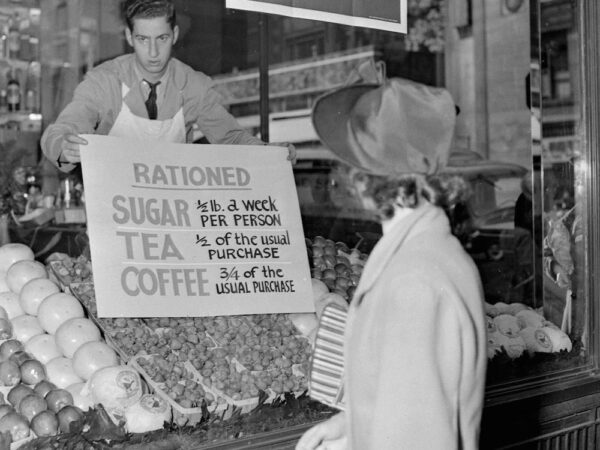Many of you have seen the excellent “Crown” mini-series on Netflix and are curious about Britain’s post-war economic problems which plagued the government in the 1960s and 70s. The economic costs of the war were enormous. Six years of warfare and the heavy losses of merchant shipping were bad enough, but Britain lost a sizeable chunk of its export trade after the war. Gold and currency reserves were depleted and most of Britain’s overseas assets were sold off. The situation got so bad that after the Lend-lease program was terminated, Britain had to borrow an additional $3.75 billion from the US at two-percent interest to pay for essential supplies. The trade imbalance with the US was so unequal that the government was obliged to extend rationing to preserve their supply of US dollars to service the debt repayments. British goods and produce were prioritized for export markets and rationing continued on until 1954.
Even grants for British industry from the Marshall Plan were used to service debt repayments. Over time, this put British industry at a major disadvantage because their French and German competitors used the money to invest in infrastructure and modernize their own industries while Britain did nothing. Germany and France may not have won the war and, of course, both were devastated by the war, but they certainly won the peace.
After WWII, the British government owed £21 billion (C$36 billion) for its war loans. Today, that debt would be worth some £940 billion (C$1.6 trillion). It took the British government exactly sixty years to reimburse the war debt with a final payment of £45 million in 2006. Remember the Montreal Olympic fiasco in 1976. The 1970 estimate for the Games was that it would cost C$120 million in total, with C$71 million budgeted for the Olympic Stadium itself. In reality, it cost C$1.6 billion, a more than 13-fold increase, due to poor planning, incompetence, outright fraud, strikes and hubris. It took the Quebec government some thirty years to reimburse the cost of this mega disaster mainly from cigarette taxes.
Canada has had its share of boondoggles. In fact, we are champions in project overruns for infrastructure projects. Remember the Mirabel airport, the 407 Express toll road, B.C.’s fast ferries, the new Champlain bridge project, the Muskrat Falls hydro-electric project, the Montreal REM public transit system, and, perhaps to come, the Quebec City tramway project which is estimated to cost C$3.3 billion to upgrade an already excellent public transport system by bus. In recent months, the Canadian government has embarked on a colossal boondoggle which will make all the others look like chump change. It has chalked up an amount of debt to the tune of around C$400 billion within a single year to pay for relief measures for the coronavirus pandemic. Every day of the week it is spending around C$1.8 billion, more than the cost of the 1976 Olympic Games. The COVID pandemic is not yet over and will continue well into 2022, the time to inoculate some 70% of the population.
The question is how long will it take us to reimburse such a load of debt. Interest rates are low today, but inflation will increase the cost of borrowing when we come out of the COVID cloud. It would not surprise me if it takes fifty years for our government to reimburse such a huge amount and the final cost might be above C$4.4 trillion if interest rates return to a healthy 5%. What will happen if we are involved in a costly war or a second pandemic with a high R0 number (like measles at 12 to 18). We won’t have any funds left to provide economic relief to our citizens.
The spendthrift Liberal government under Justin Trudeau has promised not to raise taxes in 2021 and the NDP under Jagmeet Singh is counting on a wealth tax on Canadian assets to help balance the budget. Rich families would be taxed 1% on wealth exceeding C$20 million annually. The Parliamentary Budget Office has estimated that a wealth tax would bring in C$5.6 million in 2020/21 increasing to C$6.8 million in 2023/24. A drop in the bucket, enough to pay for about 3 days of our government’s expenses. Furthermore, there has been no cutting back in government services and expenses over the last twelve months. This is the first thing that happens in private enterprise when a company is losing money or hit with unforeseen expenses. You reduce your costs by sending out pink slips. You reduce your overhead and your work force. Not so with government. There is no talk about increasing income tax, sales tax, property taxes, etc. What would Tommy Douglas think of all this? He was a democratic socialist and Premier of Saskatchewan for 17 years. He invented government-funded health insurance in 1947 and paid off the provincial debt by putting aside 10% of the provincial budget each year to pay off the debt. Where are the Tommy Douglas’s in government today?
Where will all this lead? No one in government is serious about our increasing debt load. In the future our grandchildren may have to ration food to get by as they pay off the massive loans of our national and provincial governments.
*Originally posted in March 2021


Comments ()